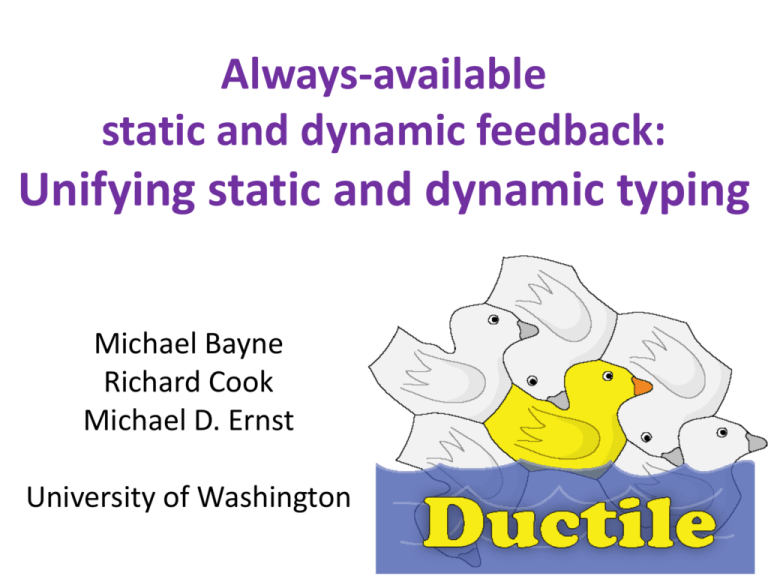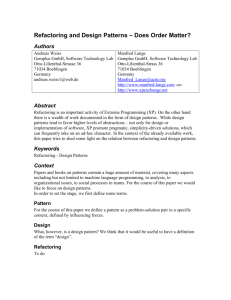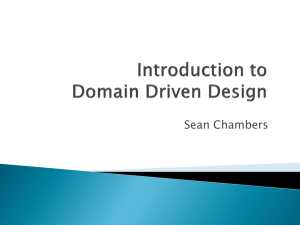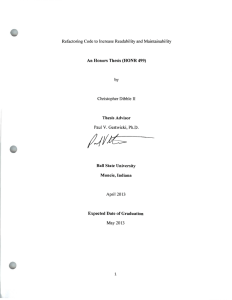Always-available static and dynamic feedback: Unifying static and
advertisement

Always-available
static and dynamic feedback:
Unifying static and dynamic typing
Michael Bayne
Richard Cook
Michael D. Ernst
University of Washington
Static feedback helps programmers
• Correctness/consistency throughout the program
• Types are machine-checked documentation
• Supports other analyses (refactoring, …)
Dynamic feedback helps programmers
• Testing builds insight, reveals emergent behavior
• Checks properties that types do not capture
– User satisfaction, algorithmic properties, …
• No false positive warnings
Complementary verification technologies
Static type-checking is not always the most important goal
Dynamic testing is not always the most important goal
Idea: let the programmer choose the best approach,
at any moment during development
– Fast, flexible development, as with dynamic types
– Reliable, maintainable applications, as with static types
Dynamic languages inhibit reasoning
Compile
• Good support for testing, at any moment
• No possibility of static type checking
Example problem:
a field crash after hours of execution
Run
Static languages inhibit testing
Compile
Run
• Support both testing and type-checking
– … in a specific order
• No tests are permitted until types are perfect
– Delays learning from experimentation
Example problem:
cannot change an interface &
1 implementation, then test
Interface
Impl1
Impl2
...
Impl99
Result: frustration, wasted effort, workarounds
Putting the developer in charge
Compile
At any moment, developer can choose:
– static feedback (sound type-checking)
– dynamic feedback (execution, testing)
The Ductile approach:
• Write types from the outset
– Programmer has types in mind
– Run the type-checker at any time
• Execute a type-erased program
– Temporarily ignore types
– Do all checks dynamically
– Execute a slice of a correctly-typed program
Run
Feedback vs. action
A user has a choice to interact with, or to ignore:
–
–
–
–
–
–
–
tests
lint
theorem-proving
code reviews
performance tuning
version control conflicts
… but no choice about the type-checker
Need to separate when feedback is
discovered and acted upon
Outline
• Motivation and approach
• Evaluation
– Prototyping
– Evolution (refactoring)
• Implementation
• Related work
• Conclusion
Prototyping case study
Goal: create an email address book
Tool: Ductile implementation for Java
Developers:
• >10 years commercial experience
• prefer statically-typed languages
Address book
architecture:
Application
Database
Duck typing and access control
interface is class InMemoryDB {
class AddressBook { Database
Detyped declaration
used but not defined
…
getName(String s) {…}
Object
Database
db = new InMemoryDB();
}
db.getName(emailAddr);
Call uses reflection
…
}
• When app is complete, define the interface
• Advantage: didn’t have to keep interface up
to date with rapidly evolving prototype
– Experimental client code had used other methods
Checked exceptions
• For “checked exceptions”, Java requires a
try/catch block or a declaration
• Deferred writing these until design was stable
• Advantages:
– Focus on main functionality while experimenting
– Don’t insert placeholder error code
– No dummy constructs: try, catch, throws
Alternative: IDE “automatic fixes”
An IDE could have made the code type-check
– Add methods to Database interface
– Set methods/fields to public
– Add try/catch blocks or declare more exceptions
This would have degraded the code
– May not indicate this is a temporary experiment
– Likely to be forgotten and left in final code
Prototyping case study conclusion
Key advantages:
• Avoid signature pollution, by deferring details
until design is stable
– Interfaces
– Access control
– Exception-handling
• Test with partially-defined code
Outline
• Motivation and approach
• Evaluation
– Prototyping
– Evolution (refactoring)
• Implementation
• Related work
• Conclusion
Evolution case study
• Proposed change in class Figure in JHotDraw:
– containsPoint(int x, int y) containsPoint(Point p)
• Goal: fast evaluation of refactoring
– Evaluate the change by running test TriangleFigureTest
– After evaluating, decide whether to continue or undo
3 key required changes:
– Figure.containsPoint: change signature
– TriangleFigure.containsPoint: change signature and body
– TriangleFigureTest: change call to containsPoint
Comparison of refactoring approaches
• Manual: 24 edits
– 14 definitions of containsPoint
– 10 calls to containsPoint
• Eclipse: 1 refactoring + 16 manual edits
– Used “Change Method Signature” refactoring
• Ductile: 3 edits
– Developer only had to make the key edits
to evaluate the refactoring
Refactoring case study conclusion
Ductile approach:
• Fast evaluation with few edits
• General approach
– Many program transformation tasks lack tool support
Need both static and dynamic feedback
in all stages of software development
Late discovery of any problem is costly
Outline
•
•
•
•
•
Motivation and approach
Evaluation
Implementation
Related work
Conclusion
Ductile implementation
DuctileJ is a dialect of Java
Transparent to use:
Add detyper.jar
to your classpath
http://code.google.com/p/ductilej/
Dynamic interpretation of static code
Write in a statically-typed language
The developer may always execute the code
To execute, ignore the types (mostly)
Convert every type to Dynamic
class MyClass {
List<String> names;
int indexOf(String name) {
…
}
}
class MyClass {
Object names;
Object indexOf(Object name) {
…
}
}
Type-removing transformation
• Method invocations and field accesses are
performed reflectively
– Run-time system re-implements dynamic dispatch, etc.
• Primitive operations (+, >, [], if) dynamically
check their argument types
• Compilation always succeeds
– Code must be syntactically correct
• Code can always be run
– Run-time failures are possible
Challenges to dynamic interpretation
1. Preserve semantics for type-correct programs
2. Useful semantics for type-incorrect programs
Preserve semantics
of well-typed programs
Goal: an execution through well-typed code
behaves exactly as under Java
Challenges:
1. Static types affect semantics (e.g., overloading)
2. Reflective calls yield different exceptions
3. Interoperation with un-transformed code
4. Meta-programming model limitations
More challenges: type resolution, arrays, final, primitive operators,
control flow constructs, widening/narrowing, annotations/enums, outer
this, anonymous inner classes, definite assignment, varargs, partially
implemented interfaces, security manager, primitive vs. object equality, …
Method overloading
Transformed declarations have same signature
void foo(int x) { … }
void foo(Date x) { … }
void foo(Object x) { … }
void foo(Object x) { … }
Overload resolution depends on static types
– Do not implement multi-method dispatch!
Solution:
– Dummy type-carrying arguments to disambiguate
– Resolution at run time if necessary
Exceptions
int readChar(InputStream in) {
try {
return in.read();
} catch (IOException e) {
return -1;
}
}
Object readChar(Object in) {
try {
return RT.invoke("read", in);
} catch (IOException e) {
return -1;
}
RT.invoke
}
does not throw
IOException
Reflective calls have different checked exceptions
– Compiler error
– Different run-time behavior
Solution:
– Wrap exceptions
– Catch, unwrap, and re-throw with correct type
Interfacing with non-transformed code
Detyper must operate on source code
Because the code doesn’t compile!
Bytecode transformation is possible for libraries
But programmer’s focus is not the library
Solution: untransformed code is treated like a
primitive operation
Signatures inherited from libraries remain
un-transformed – e.g., hashCode()
Reflection and serialization
Cannot reflectively call:
– super constructor
– super method call
– Chained constructor call
– Anonymous inner class constructor
Solution: Fight magic with more magic
Reflection and serialization observe the transformation
Solution: Un-transform signatures in results
[Tatsubori 2004, McGachey 2009]
Assessment: Preserving semantics
Program
sLOC
Tests
Google Collections
51,000
44,760
HSQLDB
76,000
3,783
JODA Time
79,000
3,688
We edited 23 lines of code and 49 lines of tests
to work around DuctileJ’s reflection/serialization limitations
Useful semantics for ill-typed programs
Give a semantics to ill-typed programs
Formalization is a research challenge
Best-effort interpretation of the program
Debugging and blame assignment
At each assignment:
Check against static type and record the result
Never halt the program because of a mismatch
If the program succeeds:
User can choose to ignore or examine the log
If the program fails:
Show relevant recorded type failures (true positives)
Innovation: Blame assignment as late as possible
Outline
•
•
•
•
•
Motivation and approach
Evaluation
Implementation
Related work
Conclusion
Combining static and dynamic typing
1. Add types to a dynamic language
2. Add Dynamic to a static language
3. Ad-hoc workarounds
Add types to
a dynamic language
Popular among academics
Scheme [Cartwright 91], Python
[Aycock 00, Salib 04], Erlang [Nyström
03], Java [Lagorio 07, Ancona 07], PHP
[Camphuijsen 09], Ruby [Furr 09], …
Not popular among practitioners
– Lack of guarantees:
compiler warnings are advisory
– Realistic programs do not type-check
– Poor cost/benefit
Add Dynamic/Object/void*
to a statically-typed language
Program is half-static, half-dynamic
Run-time type errors are possible:
the fault of dynamic code or the boundary
“Incremental/gradual/hybrid typing”
Research challenge: behavior at the boundary
– Correctness [Ou 04, Flanagan 06; Siek 07, Herman 07;
Findler 02, Gray 05]
– Blame assignment [Findler 01, Tobin-Hochstadt 06,08,
Furr 09, Wadler 09]
– Efficiency [Herman 09, Siek 09,10]
Disadvantages of adding Dynamic
Reduced benefits:
• No type-checking guarantee
• Less encouragement to good design
• No documentation benefits (where Dynamic is used)
Increased costs:
• Reasoning burden
– Identify boundary between typed & untyped
• Transformation burden
– Represent the boundary to the type system
– Later, undo work
• Boundary changes with time
Workarounds:
Emulate static or dynamic typing
• Naming conventions
• Code analysis tools
• Partial execution
– Don’t compile code with type errors
• Comment out; modify build file
• Partial execution
– Unexecuted casts
• Prototype in dynamic language, deliver in static
• IDE/editor tricks (Eclipse has several)
• … many more
Ductile provides a general mechanism
Outline
•
•
•
•
•
Motivation and approach
Evaluation
Implementation
Related work
Conclusion
Why wasn’t this done before?
•
•
•
•
•
Rigid attitudes about the “best” feedback
Divide between static and dynamic research
Aping of developer workarounds
Choices made for the convenience of tools
Difficult to design & implement
Contributions
• New approach unifies static and dynamic typing
– View whole program through the lens of full static or
full dynamic typing
– Switch views seamlessly, on demand
• The programmer is in control
– Separate feedback from action
• Implementation via
detyping transformation
– Case studies show correctness, utility
Try it! http://code.google.com/p/ductilej/







